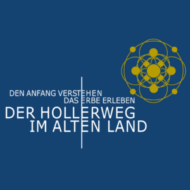OVER 700 YEARS OF POMICULTURE TRADITION IN THE ALTES LAND
The Holler colonisation made the land arable. Regular digging for clay (the nutrient-rich excavated material from the trench is distributed on the land) upheld the function of the trenches and kept the soil fertile. Benefiting from the mild microclimate, fruit flourished. Cattle grazed among the standard fruit trees. The small size of the farms forced restructuring. Livestock was abolished. For more efficient workflows, increased security and better fruit quality, the fruit is now refined on low-growing stocks. Today the Altes Land is the largest self-contained fruit growing area in northern Europe. The Obstbau-Versuchs- und Beratungszentrum, or OVB (“Pomiculture, Testing and Advisory Centre”) in Jork-Moorende serves as a competence centre for the theory and practice of pomiculture. Fruit growers, marketing organisations, distributors, developers and suppliers of pomiculture and storage technology are advised here. In addition to the scientific research for integrated and organic pomiculture that has been taking place since the 1960s, this is also where fruit farmers carry out their training. This advisory centre was established in 2000 on the operating areas of Esteburg, a former estate from 1609/11.
In 1997, 25 fruit farmers founded the Öko-Obstbau Norddeutschen Versuchs- und Beratungsring, or ÖON (“North German Eco Pomiculture Testing and Advisory Council”). From 2001 onwards, it has been located in the OVA/OVR house because of its important synergy effects. Since then, this house has been called the Obstbau-Versuchs- und Beratungszentrum, or OVB (“Pomiculture, Testing and Advisory Centre”), which focuses on pomiculture-related research and advising for integrated production and organic pomiculture.
Today, pomiculture keeps approximately 2,100 workers busy in the Lower Elbe region: 1,100 family workers, 400 permanent workers and 650 seasonal workers. The total production value of “fruit” which is generated annually in the Lower Elbe, including all types of fruit and sales forms, is approximately 180 million euros. The total cultivation area of approximately 10,500 hectares in the Lower Elbe and the core region of the Altes Land is divided into 8,200 hectares of fruit trees and approximately 1,500 hectares of berries. An ongoing structural change can be observed in the continuous growth of the businesses and the specialisation of a few fruit species and varieties. Today, apples occupy about 90% of the cultivation area.



>>> GET THE APP ! <<<

